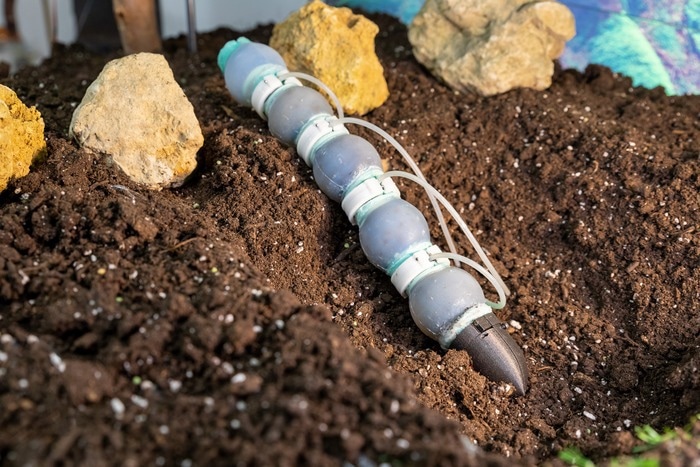
The new soft robot inspired by the biology of earthworms is able to crawl thanks to soft actuators that elongate or squeeze, when air passes through them or is drawn out. Realized by researchers at Italian Institute of Technology in Genoa Italy. Image Credit: IIT-stituto Italiano di Tecnologia.
Several examples of animals, like snakes, snails, caterpillars, and earthworms make use of the flexibility of their bodies to move and explore their surroundings. The researchers were inspired by nature and uncovered new biological phenomena while coming up with their novel technologies. This is the primary goal of the BioInspired Soft robotics laboratory coordinated by Barbara Mazzolai, and this earthworm-like robot is the newest invention from her group.
The making of an earthworm-like robot was made possible through elaborate knowledge and application of earthworm locomotion mechanics. They make use of alternating contractions of muscle layers to propel themselves both below and above the soil surface by producing retrograde peristaltic waves.
The separate segments of their body (metameres) consist of a specific quantity of fluid that has the potential to regulate the internal pressure to exert force and execute localized, independent, and variable movement patterns.
Scientists from Istituto Italiano Di Tecnologia (IIT) have gained knowledge about the morphology of earthworms and have discovered a new approach to mimic their constant volume coelomic chambers, muscle movements, and the function of their bristle-like hairs (setae).
A peristaltic soft actuator (PSA) was developed by the research group which has the potential to implement the antagonistic muscle movements of earthworms; from a neutral position, it expands when air is pumped into it and compresses when air is extracted from it. The complete body of the robotic earthworm is created from five PSA modules in series. The present prototype has a length of 45 cm and weights 605 g.
Every actuator consists of an elastomeric skin that has the potential to encapsulate a known amount of fluid, thus copying the constant volume of internal coelomic fluid present in earthworms.
The earthworm segment becomes wider circumferentially and shorter longitudinally and exerts radial forces as the longitudinal muscles of a separate constant volume chamber contract.
Antagonistically, the segment becomes longer alongside the anterior–posterior axis and thinner circumferentially with the contraction of circumferential muscles, leading to penetration forces together the axis.
Every single actuator illustrates an utmost elongation of 10.97 mm at 1 bar of positive pressure and a maximum compression of 11.13 mm at 0.5 bar of negative pressure. This is special in its potential to produce both radial and longitudinal forces in a single actuator module.
For the robot to be propelled on a planar surface, small passive friction pads have been created, inspired by the setae of the earthworms, and fixed to the robot’s ventral surface. The robot demonstrated enhanced locomotion with speeds of around 1.35 mm/second.
This study not only suggests a new technique for coming up with a peristaltic earthworm-like soft robot but also offers a deeper insight into locomotion from a bioinspired point of view in different environments.
The possible applications for this technology are enormous, such as underground exploration, excavation, search and rescue operations in subterranean surroundings, and the exploration of other planets. This bioinspired burrowing soft robot is a considerable step forward in the soft robotics field and sets the stage for additional progress in the future.
Journal Reference
Das, R., et al. (2023) An earthworm-like modular soft robot for locomotion in multi-terrain environments. Scientific Reports. doi.org/10.1038/s41598-023-28873-w.